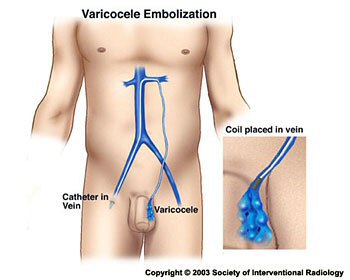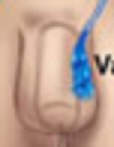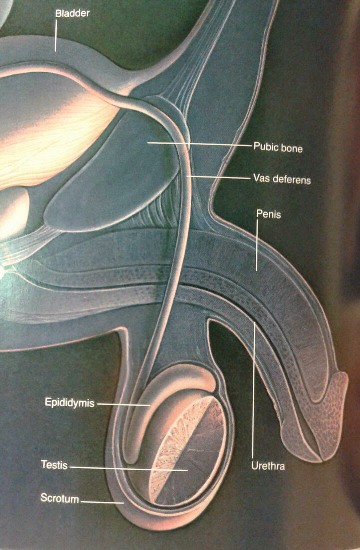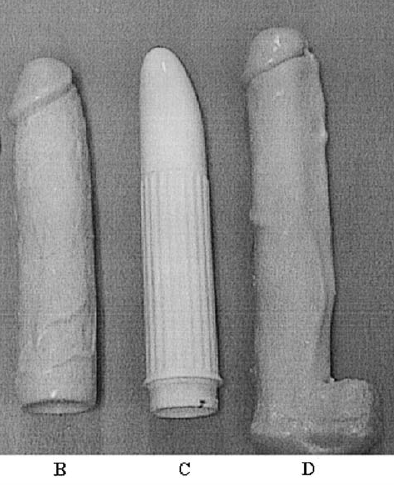| |
Remarkable Silences
"Is there any other point to
which you would wish to draw my attention?"
"The curious incident of the dog in the nighttime."
"The dog did nothing in the nighttime."
"That was the curious incident," remarked Sherlock
Holmes.
- Sir A. Conan
Doyle,
1894
|
One way male genital cutting is perpetuated is by ignoring its
existence. This is especially so in the sexual field, where to
mention it would inevitably bring its disadvantages to light.
Silence about the existence
of the foreskin
Medical resources ( ! )
Electronic:
Anatomage Table - Male Reproductive Tract
The foreskin is missing for 1' 25" of the 1' 26" seconds of
the visualisation. In the last second, the penis is sheathed in
skin, but from the back to the front and so thinly that the
foreskin is indistinguishable. It is never labelled.
e-medicine health
This site is egregious. A vague description of the corona
glandis, no mention of the foreskin:
Penis
The penis consists of three main parts: the root, the
body, and the glans penis.
- The root is attached to the abdominal and pelvic
wall.
- The body is the middle portion. The body of the
penis consists of three cylindrical spaces of soft
tissue. When the two larger spaces fill with blood,
the penis becomes large and rigid, forming an
erection.
- Two larger cylindrical spaces of soft tissue,
called the corpora cavernosa, are located side by
side and form the bulk of the penis.
- The third cylindrical space of soft tissue,
called the corpus spongiosum, surrounds the
urethra, which forms the urinary passage.
- The glans penis is the cone-shaped end or
head of the penis, which is the termination of the
corpus spongiosum. The small ridge that separates
the glans penis from the shaft or body of the penis
is called the corona.
Medically Reviewed by a Doctor on 2/17/2016
Medical Author: Stephen W Leslie, MD, FACS
Medical Editor: William
C.
Shiel Jr., MD, FACP, FACR |
Medscape

(click for larger)
The foreskin is mentioned, but not shown. An
exposed glans is presented as normal. Although that image is
sourced to
WebMD.com, that site now shows whole male genitals
in some images, not in others:
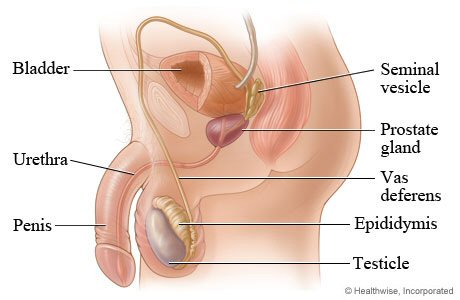
Visible
Body
(online)
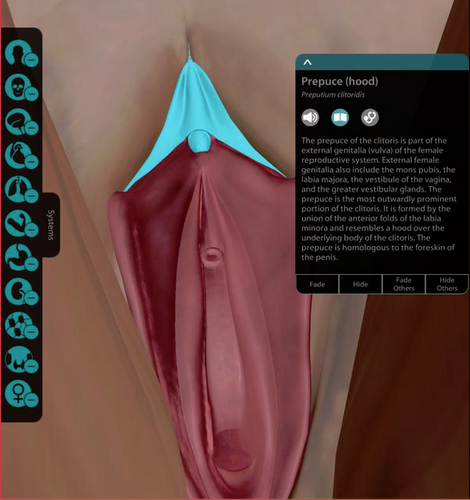
The clitoral prepuce is described as being "homologous
to the foreskin"... |

...but the foreskin is neither shown nor described |
A foreskin is promised in the next edition.
Animated
anatomy (software)
Does not show or mention the foreskin (and fails to illustrate
or mention any of the internal clitoris). A video about the software illustrates the
foreskin with a crude doodle,
and four times fails to name it. It misrepresents the history
of genital cutting and calls the dorsal penile vein an
artery! The maker rejected any criticism and had a video
rebuttal taken down, ostensibly for copyright violation.
Textbooks
Campbell-Walsh Urology (!)
Editor-in-chief, Alan J. Wein
M.D. Ph.D. Professor and Chair, Division of Urology,
University of Pennsylvania School of Medicine, Chief of
Urology, University of Pennsylvania Medical Center.
(Elsevier) 2007
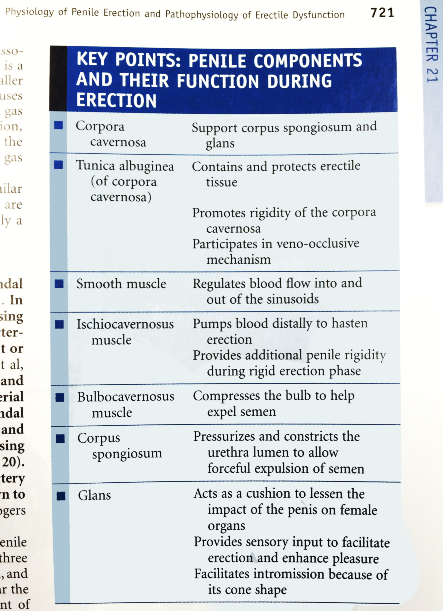
The Complete [sic]
Human Body by Dr Alice Roberts, DK Publishing (2010)
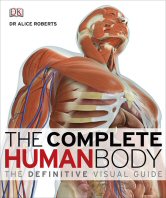
"Making full use of new medical procedures and imaging
techniques, The Complete Human Body is the definitive
guide to the development, form, function, and disorders of the
human body, illustrated with unprecedented clarity by new
computer-generated artworks and the latest medical and
microscopic imaging. Exploring the body s form and function in
greater depth than any other popular reference..." - Amazon
"...it does not once describe/depict an intact penis. All
mammals are born with a foreskin. 70 to 90 % of the world's men
HAVE their foreskin. ...
The book fails to provide any information at all about the
penile foreskin, the functions, the highly specialized nerve
endings like the [ridged] band and the Meissner's corpuscles,
the special antibodies contained therein which actually help
stave off infection, including protection from HIV/ AIDS, and so
forth...." - a customer review
Medical Dictionary at The Free Dictionary, definition of
penis.
Image from Dorland's Medical Dictionary for Health Consumers. ©
2007 by Saunders, an imprint of Elsevier, Inc. The entry for
"foreskin" is not illustrated.
Textbook of Medical Physiology
Guyton, AC, Hall, JE.
10th ed. Philadelphia: W.B. Saunders Company; 2000. p. 921.
|
Reproductive and Hormonal Functions of the Male
THE MALE SEXUAL ACT
Neuronal Stimulus for Performance of the Male Sexual
Act
The most important source of sensory nerve signals
for initiating the male sexual act is the glans
penis. The glans contains an especially
sensitive sensory end-organ system that transmits into
the central nervous system that special modality of
sensation called sexual sensation. The slippery
massaging action of intercourse on the glans
stimulates the sensory end-organs, and the sexual
signals in turn pass through the pudendal nerve, then
through the sacral plexus into the sacral portion of
the spinal cord, and finally up the cord to undefined
areas of the brain. Impulses may also enter the spinal
cord from areas adjacent to the penis to aid in
stimulating the sexual act. For instance, stimulation
of the anal epithelium, the scrotum, and perineal
structures in general can send signals into the cord
that add to the sexual sensation.
Sexual sensations can even originate in internal
structures, such as in areas of the urethra, bladder,
prostate, seminal vesicles, testes, and vas deferens.
|
New Atlas of Human Anatomy
General Editor Thomas O. McCracken
The first 3D Anatomy based on the National Library of Medcine's
Visual [sic] Human Project
MetroBooks 2001
ISBN 1486630970
$14.98
This book was given a half page in Barnes & Noble's 2002-3
holiday gift book catalogue, where the author's achievement is
described as "Dazzlingly realistic imagery" "Years in the
making" "Precise in every way."
On the book's dust cover panels we are assured the contents
"re-create visually the exact forms of the body and all its
parts" and "All the images are anatomically correct... One only
has to look at [the illustrations presented in this book] to see
that there are minor discrepancies beween these images and the
textbook examples - the missing tooth, the removed appendix. [but no mention anywhere of the missing
foreskin]. The Virtual [sic] Human's
enormous advantage over any other representation of antatomy
that has come before is that it is real, based on an actual
body, without generalisation. It is the way we are."
The Visible Human Project® is "the creation of
complete, anatomically detailed, three-dimensional
representations of the normal male and female human bodies." The
corpse of an executed criminal was scanned and sliced at 1mm
intervals.
On page 155, in the "The Male Reproductive System", two penises
are depicted, without explanation, without a square millimeter
of foreskin.
On page 149, in "The Urinary System", a standing male figure
(frontal view) is also without foreskin, as is the figure on
page 107 in "The Endocrine System".
All four illustrations imply that the reduced penis is the
natural male human condition. Unsurprisingly, the words
'foreskin' and 'prepuce' are not in the index, and nor are they
in the glossary of this Atlas of Human Anatomy. So
much for 'anatomically correct' and 'precise' -- they must have
new definitions.
At http://www.visiblep.com/
the author Thomas O. McCracken, is described as a medical
illustrator, former associate professor and director of
biomedical illustration and communication in the Department of
Anatomy and Neurobiology at Colorado State University, who has
taught medical illustration and gross anatomy, co-authored three
books, illustrated hundreds of journal articles and text books,
and has masters degrees in Medical Illustration, Anatomy and
Physiology from the University of Michigan. Strange, then, if
he'd never seen an intact penis in his life.
Essentials of Human Anatomy & Physiology
Elaine Nicpon Marieb
Benjamin Cummings (2011), 656pp
"it only showed circumcised. " - a reader on Facebook
"I searched and found "proper diagram" in chapter 14 in the
reproduction section ... It does label the foreskin, but unless
you were looking for it, you wouldn't really know what they're
labeling." - another reader
The University of California, San Diego,
Practical Guide to Clinical Medicine website
has a
photograph called "normal male genitalia" in which the
penis is circumcised.
Pocket Anatomy: A complete guide to the Human Body for Artists
and Students by Christopher Joseph, New Holland, 2006,
"based on Gray's Anatomy". All penises are shown flayed. (Gray's
Anatomy - of course - has a detailed description of the foreskin.)
Complete Book of Men's Health
senior editor Penelope Crean
Mitchell Beazley (Octopus), UK, 1999.
No mention of the foreskin or circumcision. The only
illustration of a penis is erect, in cross-section, with no hint
of a foreskin. The double page spread on the stages of sexual
arousal is entirely based on Masters
and Johnson, admitting they have been criticised for
over-generalising, but says "Masters and Johnson's text remains
the standard point of reference."
Sexual Behaviour in the Human Male
Alfred Kinsey, 1948.
No mention of the foreskin or circumcision. A significant but
unknown proportion of men born in the USA
before 1930 would have been circumcised.
Shands
Health
Care website
"Male reproductive anatomy":
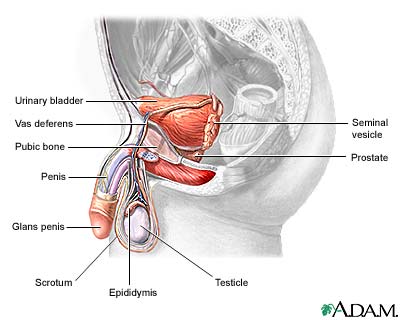
The
male reproductive structures include the penis, the
scrotum, the seminal vesicles and the prostate.
A.D.A.M.,
Inc. is accredited by URAC, also known as the
American Accreditation HealthCare Commission
(www.urac.org). URAC's accreditation program is the first of its kind, requiring
compliance with 53 standards of quality and
accountability, verified by independent audit.
A.D.A.M. is among the first to achieve this
important distinction for online health
information and services. Learn more about
A.D.A.M.'s editorial reviewers . A.D.A.M. is also a founding member of
Hi-Ethics (www.hiethics.com) and subscribes to
the principles of the Health on the Net
Foundation (www.hon.ch).
|
Other sequences begin with pictures of circumcised penises
identified as "normal anatomy". When this lack was pointed out
to http://www.adamimages.com,
their Education Support departnment replied, "There are many
images with and without foreskin as there are people with and
without." There are amputees, but would an anatomical picture of
a leg have a foot missing?
An anatomical model
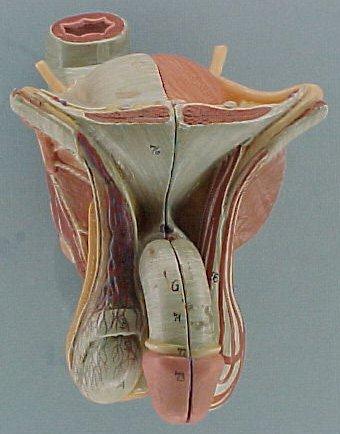
Other
pictures of the same model.
Health
Infection
blogspot
(This seems to be a cut-and-pasted blog, with no information
about the surgical procedure shown.)
Jones and Bartlett's online Paramedic A&P Anatomy
Review
of The Male Reproductive System illustrates the
foreskin -
 - but does not idenitfy or test for it, though it tests for and
identifies the rectum, anus and pubic symphysis - not normally
considered parts of the male reproductive system.
- but does not idenitfy or test for it, though it tests for and
identifies the rectum, anus and pubic symphysis - not normally
considered parts of the male reproductive system.
A news item about a man's suicide after genital cutting

The foreskin is shown as no thicker than the
shaft skin and misidentified as the glans penis, to which it seems to be
attached at the meatus.
The scrotum appears to be acting as a retractable "foreskin"
to the testis!
A scientific study
|
Flesh
and Blood,Perspectives on the Problem of
Circumcision in Contemporary Society, pp17-26
An Analysis of the Accuracy of the Presentation of
the Human Penis in Anatomical Source Materials
by Gary L Harryman
Abstract
The purpose of this study is to identify and analyze
the accuracy of the anatomical source materials
regarding the human penis that are immediately
available to medical school students and medical
professionals. Ninety sources were vetted for entries
and images of the penis — definitions, photos,
illustrations, and drawings. We fmd 67% of the
depictions of the human penis are anatomically
incorrect. Of the primary images of the human penis,
71% are incorrect, while 54% of the secondary are
incorrect. It is evident that the penis is
misrepresented in the medical literature used in
medical schools. The penis is routinely defined and
depicted in a partially amputated condition, as if
this were a natural state, without explanation or
caveat. This study indicates that students are being
misinformed about fundamental anatomy.
...
3. FINDINGS
3.1 Principal Findings
In the 90 sources, we found three hundred sixty-five
(365) images of the penis. Of these 365 images, one
hundred twenty-two (122), 33%, showed anatomically
correct depictions of the foreskin, while two
hundred forty-three (243), 67%, showed
penises from which the foreskin had been amputated.
Of those 243 disfigured images, only one includes an
explanation of why the foreskin was absent. When the
primary images (which present the penis as the direct
subject of study or discussion) and secondary images
(which show the penis incidental to an image of
another organ, e.g. the bladder or the hip joint), are
distinguished and separated, we fmd that primary
images are more often incorrect than secondary images.
Out of two hundred seventy-two (272) primary images of
the penis, only seventy-nine (79), 29%, were
anatomically correct in their depiction of the
foreskin. One hundred ninety-three (193), 71%, were
anatomically incorrect (i.e. foreskin absent) in their
depiction of the foreskin. Out of ninety-three (93)
secondary images of the penis,4 forty-three (43), 46%,
were anatomically correct in their depiction of the
foreskin. Fifty (50), 54%, were anatomically incorrect
in their depiction of the foreskin.
|
Sex advice
Hands Free Orgasms! by
Watts The Safeword on YouTube
published on September 22, 2017. Uses an image apparently
derived from WebMB
"His G-Spot (and 7 Other Hidden Moan Zones)",
Cosmopolitan magazine, June 2008, p121, covers everything from
prostate massage to the ear, the chest, nipples, scrotum, raphe,
and frenulum:
"This band of tissue has more nerve fibers intersecting it
than any other body part does..." [except
the foreskin].
The word "foreskin does not appear in the article.
How to Drive Your Man Wild in Bed by Graham Masterton
and Liz Coldwell, Black Lace (Virgin), London, 2004, chapter 5
The Perfect Penis:
The plum-like head of the penis or glans (sometimes, because
of its shape, called "the helmet") is full of hypersensitive
nerve endings. Probably the most sensitive part of the
whole organ is the frenum [no, only the less-than-whole organ]...
Extended Massive Orgasm by Steve Bodansky and Vera
Bodansky, Vermilion, London, 2000. The chapter "Know Your Body"
explains and illustrates the clitoris, the clitoral hood and its
retraction, and says
- "More nerves fill the clitoris than fill the head of the
penis: approximately eight thousand nerves, about twice as
many as the penis has." (p 51)
- "The apex, or the underside of the head of the
penis, and the clitoris develop from he same embryologic
tissue and are considered homologous. Homologous means "to be
similar to" and it describes similar structures that share a
common origin. ... It's been determined that only the uterus
lacks a homologous organ in men." (p 57)
- "It is also thought that the clitoris moves against its own
hood as the penis thrusts in and out," (p 58)
- In a section on "Masturbation for Pleasure - for men -" it
says "We recommend you use Vaseline for this exercise."
"...narrow your focal point to your apex (the underside of the
head of the cock, which is the most sensitive area)."
No mention of the frenulum, let alone the penis's "own hood", its
thousands of nerves, its exquisite sensitivity, or the way it
moves against the glans as the penis thrusts in and out, making
other lubricant unnecessary. The term "apex" is not in common use.
(The book uses a number of words including "peak" "tumesce" "do"
and "squirt" in non-standard ways.)
The chapter "How do you do?" has 3 1/2 pages (89-93) about
"Touching a Man" with no reference to his foreskin.
The Complete Guide to the Penis, in Tiscali
Health. A caption "Prepuce" on an illustration of a
dissected penis points to the corona. There is no other
reference.
![Anatomical diagram from ''The [Inc]omplete Guide to the Penis''](Images/%27%27complete%27%27.gif)
"Sex for Life: The Lover's Guide to Male Sexuality" by
David Saul, MD. Apple Publishing, Vancouver, 1998 - does not
refer to the foreskin or circumcision in the text or the index,
only in two of the jokes with which he ends each chapter. One
has the punchline
"Don't worry," said the tailor excitedly. "When you rub the
wallet a little it turns into a briefcase."
- which admits that the foreskin is erogenous
tissue. The penises shown in a few small drawings are all
circumcised.
"Taoist Secrets of Love: Cultivating Male Sexual Energy"
by Mantak Chia and Michael Winn, Aurora Press, Santa Fe, 1984, -
other than ambiguous photos, shows circumcised penises as if
normal.
"Male Sexuality" by Bernie Zilbergeld, PhD, "The first
book that tells the truth about men, sex and pleasure" (Little,
Brown 1978), in 11 pages about the penis, does not mention the
foreskin or circumcision. Drawings of two intact flaccid penises
in a group of six and one possibly intact erect penis in a group
of five are not identified. The only anatomical cross-section
diagram is of a circumcised penis (identifying only "erectile
tissue" and "urethra").
"For many men the head is the most sensitive part of the
penis, especially around the ridge that connects it to the shaft
of the penis."
That ridge is the remnant of the foreskin remaining after
circumcision. That in itself should be indicative.
The Marriage Art by John E. Eichenlaub, M.D.,
Mayflower-Dell paperback © 1961, reprinted 1965, 1965, 1965,
1966, 1966, 1967 and 1967, nowhere mentions the foreskin or
circumcision:
"Most nerve centers contributing to sexual excitement lie
near the vaginal opening in the female and around the penile
head in the male." (p24)
The final trigger of male sexual excitement is the frenulum,
the thin fold of tissue just beneath the penile head. This
fold and the small area of tissue adjoining are a man's
keenest sexual triggers." (p58)
The blurb says:
A doctor
speaks:
"Dr Eichenlaub's book is frank, complete
and to the point ..." 
-Richard R. Fliehr, M.D.
The
Word, a site for New Zealand teenagers, mislabels a
circumcised glans as "foreskin /kirimata":
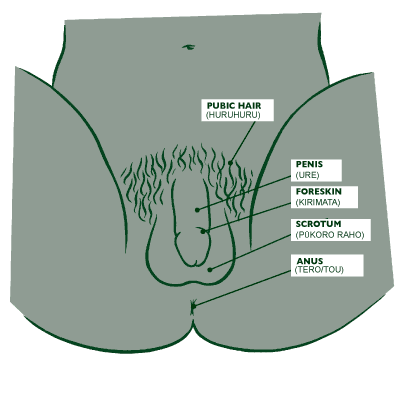
Sex-eduction materials for pre-teens
used in New Zealand schools (virtually all non-Muslim
non-Pasifika NZ pre-teens are intact)

- from a TV news item about a
conservative group complaining about the materials,
January 11, 2017
Luke Warm Sex, an Australian comedy documentary
TV series: "Therapists, sex coaches & scientists
give Luke McGregor a crash course in great sex." In a
sequence (Series 1, Episode 4 "It's a Pleasure to Meet
You") about the penis, a sex coach demonstrates using a
cucumber held between his thighs. The foreskin is not
mentioned. The coach apparently regards the use of oil
as essential.
Behind Closed Doors: The Erogenous Zones
by Elizabeth B, in The Flat Hat (student
paper of William and Mary College), October 2, 2017
|
I cannot count the number of pop culture
articles I’ve read about the female body in
modern culture where the vulva was referred
to as a vagina. I realize that in high
school sex-ed (if you had it), the anatomy
sections felt like the most obvious and
useless information. I vaguely remember
shaking my head at a dust-flecked projector
diagram of the male reproductive organs,
thinking, “This is all true, but what is one
supposed to DO with this information?”
Anatomy lessons without indicating erogenous
zones reduce sex-ed to half abstinence-only
scare tactics, half snooze fest.
...
1. Female Genital Erogenous Zones.
...
2. Male Genital Erogenous Zones
The penis. Not all areas of the penis are
created equal. The glans (aka the head of
the penis) operates in a similar nature to
the clitoris in that therein lies the
majority of the penis’s nerve endings [if the foreskin has
been cut off]. The most are
along the outer ridge. The frenulum is the
v-shaped spot just below the glans. Although
some
circumcisions include removal of the
frenulum, and it does not contain
quite as many nerve endings as the glans, if
present, it offers another erogenous zone to
provide attention to. The shaft has the
fewest nerve endings (not to say that it
should be neglected) and thus may be most
responsive to varying pressures and
sensations. One last note: that ridge or
seam on the underside of the penis is called
the perineal raphe, and it may also be a
more sensitive area of the shaft for some
individuals.
The scrotum and testes are a tremendously
sensitive erogenous area and should
generally be treated with care. Consider the
discomfort and pain often associated with
the testes. To treat the scrotum and testes
with the tender love and care they deserve,
as always, communicate with your partner.
For some, good sex would not be the same
without a little scrotal love, while others
may prefer that you avoid this area
altogether.
The prostate — how
could I talk about male erogenous zones
without bringing up the prostate?
It’s a walnut-sized gland which can be
stimulated indirectly either via the
perineum or the wall of the rectum which
faces the belly button (like finding the
G-spot, you may wish to use a come hither
motion).
3. Genderless Erogenous Zones
...
4. Pleasuring Intersex and Trans
Partners (and a General Tip)
...
[No mention of the
foreskin whatever.]
|
Movies and TV
These productions anomalously portray penises that would
actually be intact as circumcised:
Movies
TV
- A newborn baby in "Big
Love"
- A baby born in the street in "ER"
- A penis grown from human DNA on the back of a mouse in "South Park"
The movie "Sex and
Breakfast"(US, 2008) includes a scene of a sex
education class including a chart on which a circumcised penis is
shown as normal.
Standup comedy on TV: Bill
Maher in Oklahoma
(53' in)
"Couple of years ago, our friends at Pfizer came out
with "Lady Viagra" as it was dubbed in the media which,
it was said, would "even things out", which is silly on
a number of levels, first of all, women as we all know
have gotten a raw deal throughout all of history, in
almost every civilization including up until today.
The one area where they got lucky, and don't
need evening out was sex, I mean just - multiple
orgasms, you win! You know, you have a machine gun, we
have a musket! (applause) Don't even ask about
(gestures reloading a musket) trying to reload
that thing, naa, with the powder and the - half the
time it blows up in your face. (applause)
But not just multiple orgasms, multiple zones!
Women have a vagina and a clit and
a G-spot - a G-spot? They only found it in 1985.
That's how complicated women are, they were still
discovering shit there in the '80s!
They came to me in 1985 and said to me "Ah Bill,
we've detected a third ball, that I think -"
[Taylor first described the ridged band of the
foreskin in 1995.] And I'm sure when I
was ticking off that list of erogenous zones, that at
least some of you out there were saying, "Oh, come on,
Bill, what about the asshole?" [At
least some of us out here were saying, "What about
the foreskin?"] Oh, we talked about him
the whole first half of the show! It's not all about
you Donald Trump! (applause) This is about me!
|
Others omitting the foreskin
The Incredible Machine, National
Geographic Society, 1997
Scientific American
The normally scrupulous Scientific American ran an article in
August 2000 by Irwin Goldstein and the Working Group for the
Study of Central Mechanisms in Sexual Dysfuntion on "Male Sexual
Circuitry". The otherwise admirable article recognises the
existence of the foreskin only in a picture of an ancient Greek
herm.
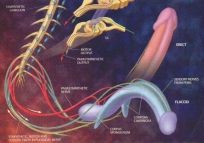
Its diagrams of penile anatomy show a flayed penis, the
nerves emerging from under the glans: |
 |
The New Zealand Listener, April 15 2006
An article about the funding of \/iagra for prostate cancer
survivors, using an illustration attributed to "Getty". A search
of Getty Images on "male genitourinary" finds several others
portraying the normal penis as circumcised.
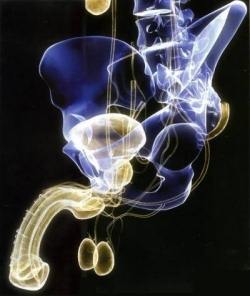 |
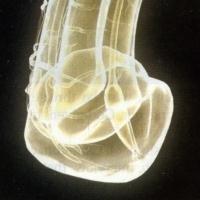
The glans appears
to be turned three-quarters towards us. The veins
encircling the shaft end at the glans without
explanation. |
A would-be scientific study of intercourse
Gallup GG Jr, Burch RL, Zappieri ML, et al., The
human penis as a semen displacement device, Evolution and
Human Behavior 24 (2003) 277–289
Abstract
Inanimate models were used to assess the possibility that
certain features of the human penis evolved to displace
semen left by other males in the female reproductive
tract. Displacement of artificial semen in simulated
vaginas varied as a function of glans/coronal ridge
morphology, semen viscosity, and depth of thrusting.
Results obtained by modifying an artificial penis suggest
that the coronal ridge is an important morphological
feature mediating semen displacement.
...
2.1. Methods
The genital models are depicted in Fig. 1. The latex
phallus B was 155 mm long and 33 mm in diameter (Hollywood
Exotic Novelties) with a coronal ridge extending
approximately 5 mm from the shaft. The latex phallus D was
the same length, but was 27 mm in diameter with a coronal
ridge extending 3 mm from the shaft (Hollywood Erotique
Novelties). The plastic shaft C lacked a coronal ridge,
measured 155 mm in length with a diameter of 29 mm, and
was used as a control phallus. These dimensions are well
within human parameters. |
The words "foreskin" and "prepuce" appear nowhere in the text, and
"circumcision" only in the title of a cited book (entirely about the role of the
foreskin in sex), while the part cited does not refer to the
foreskin or circumcision.
This study has been widely quoted, and forms a chapter of a book,
"Why is the Penis Shaped Like That?" by Jesse
Bering in which the words do not appear either.
|
BBC
Last Updated: Thursday, 7 August, 2003, 00:44 GMT
01:44 UK
Penis is a competitive beast
Scientists
believe the shape of the penis may have evolved to
help men remove the semen of love rivals during
sex.
Tests
led a team of US researchers, headed by Professor
Gordon Gallup, to conclude that the penis acts as a
"semen displacement device" and its shape has
evolved in part to displace another man's semen.
The
team from the State University of New York believe
the thrust of the penis during sex may help to clear
a woman's reproductive system of a previous lover's
semen.
They
tested their theory in experiments using latex
phalluses, an artificial vagina and a mixture of
starch and water.
New
Scientist magazine reports they found the coronal
ridge of the penis, found where the glans, or head,
meets the shaft, could scoop out more than 90% of
the cornstarch mixture with just one thrust. A
phallus with no coronal ridge only managed to remove
35%. They found the depth of thrusting was also
important. A three-quarter thrust was found to clear
out less than 40% of the viscous mixture.
...
'Far
fetched' theory
Mr
Derek Machin, a urologist at University Hospital,
Aintree, said the theory seemed "far fetched".
"The
research might very well be accurate, but I'm not
convinced that just because the penis does something
like this it was necessarily designed to have that
effect."
...
The
research is published in the journal Evolution and
Human Behaviour.
|
New Scientist
In the issue of 14 September 2002, in an article ("Frontiers" p
14) on the growing of penile tissue in vitro, a
cross-section of a penis is shown, circumcised for no apparent
reason.
"The Myth of Monogamy"
"The Myth of Monogamy: Fidelity and Infidelity in Animals and
People" by David P Barash PhD and Judith Eve Lipton MD, Freeman,
New York, 2001 has a page (167-8) about the size and shape of
the human penis and the possible role of its corona
glandis in removing previous partners' sperm from the
vagina, but no mention of the foreskin.
"Body Bazaar"
"Body Bazaar: The Market for
Human Tissue in the Biotechnology Age" by Lori B. Andrews and
Dorothy Nelkin blows the whistle on the ethics of tissue
research, patenting of DNA and genomes, and the harvesting of
body parts, from the dead as well as the living (including their
use in art).
Its index does not include the words "skin" "foreskin"
"circumcision" "Apligraf (TM)"
"Dermagraft (TM)"
or "Organogenesis".
Chapter 2, "Biocommerce" (rather mysteriously subtitled "The
People in the Body") focuses on the medical trade in body parts,
including:
- blood
- eggs
- sperm
- pheromones (in sweat)
- DNA
- stem cells
- bone
- embryos
- antibodies
- ovarian tissue
- placentas
- the meninges of the brain and
- muscle
- but not foreskins.
It is, nonetheless, an excellent
resource for legal precedents for challenging this trade.
A sexual theme park!
A "sex theme park" called "Love Land," featuring a Phallus
Garden, was opened in 2004, on Jeju Island, Korea. Apparently
none of the many phalluses there is intact.
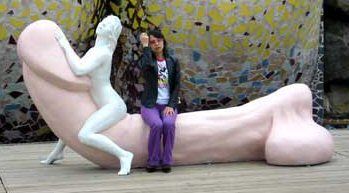 Contrast this with the Penis Day
celebrations in Japan. Wikipedia
entry
Contrast this with the Penis Day
celebrations in Japan. Wikipedia
entry
The Body: a Guide for Occupants by
Bill Bryson (Doubleday Canada, 2019) details the four kinds of
nerve-endings and goes into detail about men's ignorance of female
anatomy, especially the clitoris: does not mention the foreskin.
Silence about circumcision
FrontPage
reprinted at Nospank
The Sexual Rage Behind Islamic
Terror
By
Jamie Glazov
FrontPageMagazine.com, October 4, 2001
ALL SERIAL KILLERS, almost without exception, are
severely sexually abused as children. The kind of
people who hijack a plane with innocent people and
drive it into a building with thousands of other
innocent people are related to this phenomenon.
When sociopaths rape and kill, they do not see their
victims as human beings, but only as objects. This is
because the sociopaths were themselves, at one time,
used as objects - as their bodily
integrity was repeatedly violated. The rage
that results from sexual abuse is one thing, but when
combined with living in a dysfunctional culture of
sexual repression and misogyny, where love is reduced
to violent domination, it is quite another. ...
The sexual privileges that are allowed in Islamic
cultures are permitted to men. ... A deep-seated fear
of, and hostility to, individuality prevails, and its
main expression exists in misogyny.
Socially segregated from women, Arab men succumb to
homosexual behavior. ... The male who is penetrated is
emasculated. The boy, however, is not, since it is
rationalized that he is not yet a man.
...As the scholar Bruce Dunne has demonstrated, sex
in Islamic societies is not about mutuality between
partners, but about the adult male's achievement of
pleasure through violent domination.
There is silence around this
issue. It is the silence that legitimizes
sexual violence against women, such as honor crimes
and female circumcision.
It is also the silence that forces victimized Arab
boys into invisibility. Even though the society does
not see their sexual exploitation as being
humiliating, the psychological and emotional scars
that result from their subordination, powerlessness
and humiliation is a given. Traumatized by the
violation of their dignity and manliness, they spend
the rest of their lives trying to get it back. ...
[Unmarried males'] sexual outlet mostly includes
victimizing younger males - just the way they were
victimized. ...
It is ...no surprise that many of these males find
their only avenue for gratification in the act of
humiliating the foreign "enemy," whose masculinity
must be violated at all costs - as theirs once was.
Violating the masculinity of the enemy necessitates
the dishing out of severe violence against him. In the
recent terrorist strikes, therefore, violence against
Americans served as a much-needed release of the
terrorists' bottled-up sexual rage. Moreover, it
served as a desperate and pathological testament of
the re-masculinization of their emasculated
selves.
[There is silence in this
article around the circumcision of virtually all
Arab boys - at an age they can remember it. It is
the same silence that legitimises the
victimisation of boys by circumcision throughout
the world - but especially the US.]
Jamie Glazov holds a Ph.D. in History
with a specialty in Soviet Studies. He is the author
of 15 Tips on How to be a Good Leftist.. ... He
writes the Dr. Progressive advice column for
angst-ridden leftists at EnterStageRight.com. E-mail
him at jglazov@home.com.
The entire
article may be seen on a separate page.
|
"Crossroads: The Quest for Contemporary Rites of
Passage" edited by L.C. Mahdi, N. G. Christopher and Michael
Meade, contains 49 articles about initiation. Circumcision is
not mentioned once. Asked why, Mahdi replied, "we intended that
"Crossroads" would focus mainly on rites of passage at
adolescence." Historically, circumcision is by far the most
common rite of passage for adolescent men.
"Stop Teaching Our Kids to Kill" by Col. Dave Grossman.
He writes about TV, movie and video game violence turning boys
violent, and how military indoctrination is to turn a man into a
killer but, challenged to consider circumcision, he scoffed,
"Right, cutting off a boy's dick makes him violent."
"The Shrine of Jeffery Dahmer" by Brian Masters
(Coronet/Hodder & Stoughton, 1993) discusses the infant
Jeffrey's vaccinations, breastfeeding, an operation for inguinal
hernia ("an invasion near his genitals") and their possible
effects on his self-image - but not circumcision. (Whether he
was circumcised or not we still do not know, still less what
effect this might have had on his self-image and subsequent
career as a serial killer; but a late, remembered circumcision
does seem to have been influential in a
similar case.)
"Why They Kill: The Discoveries of a Maverick
Criminologist" by Richard Rhodes
"Angry Young Men" by Aaron Kipnis
Books and articles
about unnecessary surgery
MSN.com Health
|
Do
You
Need This Surgery?
Millions
of Americans are having operations on their knees,
backs and sinuses. Should you?
By Dr. Ranit Mishori, PARADE Magazine
More on this in Health & Fitness
Courtesy of PARADE
More
than 70 million Americans face surgical procedures
every year. Are they all necessary? Probably not.
Even the simplest operation is a serious
undertaking. “No surgery is
minor,” says Dr. Thomas Russell, executive
director of the American College of Surgeons. There is always a possibility that
something can go wrong when someone sticks a sharp
blade in your body.
Sometimes
surgery is the only available treatment. In other
cases, however, less-invasive options should be
tried first. Whether or not you go under the knife
may even depend on where you live. “There’s evidence
that in some parts of the country, certain
procedures are overdone,” says Dr. Russell. [One
procedure is overdone in all parts of
the US.] “But other communities take
a conservative approach and require you to go
through hoops and hurdles before you have surgery.”
...
Knee surgery ... Back surgery ... Sinus surgery
...
Ultimately,
elective surgery is about making you feel better.
And it’s you, the patient, who must decide the right
course of action for your needs, carefully choosing
the time, the place and the doctor. Educate yourself
about any procedure and ask questions. You must be
convinced that the benefits of what may be a
short-term solution to your problem outweigh the
risks.
Questions
To Ask About the Surgery
- What
are the risks and benefits?
- What
are the latest techniques and surgical options?
- Is
there evidence that this surgery is effective?
- How
many people achieve full recovery?
- How
long is the recovery?
- What
can go wrong?
Questions
To Ask About the Timing
- Do
I need the surgery right now?
- Do
I have other options?
- What
happens if I wait a while?
- Can
I wait too long?
|
Ms.
Oct-Nov 2000
Making
the Cut
BY
MARTHA COVENTRY
On New Year's Eve, I sit with an
acquaintance and talk. We are nearing the end of a
long, pleasant evening. My friend, also a writer,
leans towards me into the little circle of privacy
we've created "So you mean
what happens to African girls?" she asks,
after I tell her what I am working on. "No,"
I say. "I mean what happens to children in the
United States."
|
Or rather, what happens to girls...
|
As late as 1937, Holt's Diseases
of Childhood. a respected medical-school text,
stated that the author was "not averse to circumcision
in girls..."
|
This is the only use of the c.
word.
|
Over the past 50 years, medicine has
established standards for female and male bodies. ...
Girls should have vaginas fit for future intercourse,
and boys should have urethral openings at the tip of
the penis.
|
...so the true tip of the penis, the
foreskin, is cut off. But this is not what
she means, she's referring to operations to
"correct" hypospadias,
where the urethra does not emerge from the
tip of the glans.
|
Approximately 2,000 children a year
have genital surgery in the U.S.
| The true figure is approximately 1,200,000
children a year... |
Experts say the vast majority are girls who lose parts
of their clitorises and, less commonly, little boys
who are changed into girls in an attempt to give them
what doctors believe will be a better life.
Journalist John Colapinto recently
wrote a book called As Nature Made Him: The Boy
Who Was Raised as a Girl. It's about the
boy John Money put forth as evidence that we can
make a child any sex we want if we get to her or him
early enough.
|
... but no mention that David Reimer's
troubles stemmed from a botched, unnecessary
circumcision.
|
After reading of [John Money's PhD
thesis arguing against genital reassignment surgery]
and knowing what followed - the
long-unexamined practice of cutting into children's
genitals to make them more acceptable - the
practice seems like a sad, avoidable mistake.
|
... but the sad, avoidable, mistaken
practice of cutting into healthy boys'
genitals to make them more
acceptable remains unexamined a bit longer.
|
...we're appalled by countries that
routinely clitoridectomize their daughters. But we
still treat a bigger than average clitoris on a child
as fair game.
|
With all its wilful blindness
to male circumcision, this article does make
the point that - even today - doctors will
partially or wholly clitoridectomise baby
girls at the drop of a hat if their clitorises
are "too big", and all the familar
"locker-room"-type arguments will be wheeled
out.
The struggle against genital mutilation -
whether of boys, girls
or children of
other gender - is one struggle.
Ms Coventry has written another article, below.
|
|
On The Issues
The Progressive Woman's Quarterly
Summer 1998
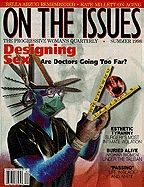
 |
The
Tyranny of the Esthetic
Surgery's Most Intimate
Violation
by Martha Coventry |
Sexual
conformity at the point of a knife is being
forced on women whose genitals are declared
not "normal" [and
on baby boys whose genitals are
perfectly "normal"] -- with
devastating results
|
... Clitoral surgery on children is brutal and
illogical, and no matter what name you give it, it is
a mutilation. When I
use the word mutilation, I can hear doors slamming
shut in the minds of doctors all over this country.
John Gearhart, a pediatric urologist at Johns Hopkins,
has said, "To compare genital mutilation of young
girls in Africa to reconstructive surgery of a young
baby is a giant, giant leap of misrepresentation." ...
Gearhart's mistake is to judge surgery only by the
surgeon's intent, and not by the effect on the
child....
Of the notable feminist voices raised long and loud
in outrage over traditional genital surgeries
practiced in parts of Africa, which are now denounced
as "female genital mutilation" (FGM), not a single
woman has said a word about the equally mutilating
practice of surgically destroying the healthy genitals
of children in their own country. [And
in her treatment of circumcision, Ms Coventry
carries on that tradition.] ... Could
their silence be because they don't know what is
happening in American hospitals? It's possible, but
this issue has received media coverage in the past
year, and many of them have had the facts explained to
them in person or in writing.
I could speculate that these women don't want to take
on a foe as formidable and familiar as the medical
profession, and that it is simpler to point fingers at
more barbaric countries. They may not want to dilute
their cause with the sticky subjects of sex and gender
that surround the issue of ambiguous genitalia [and "normal" male genitalia].
...
Each woman has her own reasons for turning away from
this issue. But I challenge them to pay attention to
the fact that in hospitals just down the street in any
big American city, five [no,
3,300] children a day are losing
healthy, erotic parts of their bodies to satisfy a
social demand for "normalcy." There is no Federal ban
to save them. The surgery is left out of the law
against FGM because it is deemed "necessary to the
health of the child on whom it is performed." [Boys
do not even have that much protection.
Circumcision may be legally performed for any
reason or none.] But as social
psychologist Suzanne Kessler at the State University
of New York at Purchase points out, "Genital ambiguity
is corrected not because it is threatening to the
infant's life, but because it is threatening to the
infant's culture." [or
rather, to the parents' culture]
Doctors and
parents believe society will reject a child with
atypical genitals, and the child is made to pay with
her or his body for this shortcoming of our culture.
What is happening in American hospitals to healthy
children is just as mutilating to the bodies -- no
matter how exquisite the surgical craftsmanship -- and
violating to the souls of these children as FGM. And
frequently, the surgical craftsmanship falls far
short of exquisite.
The strict sexual agenda for bodies in America
extends to little boys as well. [Yes!
-
and then, more silence:] To grow up to
be a real man, a boy will have to be able to do two
things -- pee standing up and penetrate a vagina with
his penis. If a little boy has to sit like a girl to
urinate because his urethra exits somewhere along the
shaft of his penis rather than the tip (a condition
that can occur in as many as 8 out of 1,000), he may
be subjected to many disheartening surgeries over the
course of his childhood to correct this "defect," and
be left with a lifetime of chronic infections and
emotional trauma. And if the baby is born with a
"too-small" penis that doctors decide will never be
big enough to "successfully" penetrate a woman,
physicians will probably make him into a "girl"
through surgery and hormone treatments, because, in
the words of one surgeon, "It's easier to poke a hole
than to build a pole." [And
if a baby is born with any penis at all, US
physicians will probably remove his foreskin.]
In the 40 years since surgical intervention to
"correct" genitals that are viewed as abnormal was
first prescribed [and in the
120 years since circumcision was first prescribed
for "moral hygiene", i.e. to hinder masturbation],
treatment protocols have rarely been questioned. After
all, it is much more comfortable for doctors to assume
all is well than to start digging around to find out
if it's really true. Until recently, all discussions
of what is done to people's sexual bodies have been
hidden safely away in the pages of medical texts,
where real lives are only "interesting cases," and
pictures of genitals are disembodied curiosities or
teaching tools. Many doctors would like to keep things
that way. For example. Dr. Kenneth Glassberg, a
pediatric urologist associated with the American
Academy of Pediatrics (AAP), insists that people who
speak up and tell their stories are doing a disservice
by "scaring patients away."
... Cosmetic genital surgery
on children is out of control. As the
practice has careened along unexamined for decades,
illustrious careers and reputations have been made,
consciences have been swallowed, and terrific damage
has been done. For a doctor
even to hesitate before operating takes tremendous
effort and self-reflection. The need for babies to
have genitals that look typical has been perceived
as so unquestionable
that surgeons travel all over the world to perform
surgery on children free of charge as a "humanitarian
gesture."
Dr. Justine Schober challenges her fellow surgeons to
realize that "when you do [this kind of] surgery on
someone, you are responsible for them for the rest of
their lives." ... No one is naive enough to say that a
life in a body seen as abnormal is a ticket to bliss.
But it is not the bodies of
these children that are wrong, it is the way people
see them. And if these children grow up and want to
change their bodies one day, that will be their
right. Nobody, but nobody, no matter how loving, no
matter how well-intentioned, should have the power
to steal precious parts of a body from a child
before she or he even gets started in life.
Martha Coventry is currently writing a
book about childhood genital surgery in America. [We wait with bated breath to see
what it will say about circumcision - if anything.]
She lives and works in Minneapolis.
|
On The Issues. Summer '98, Vol. 7, No. 3 / Web
page: 6-26-98.
They can not argue that circumcision is omitted because they
confine themselves to women's issues, since an earlier article
asks Do
feminists need to liberate animals, too?
Gender-conformity surgery is a
violation of the human right to genital integrity. To grant the
validity of part of that right is not to deny the validity of
another part.
Review
of
“Civilizing Women: British Crusades in Colonial Sudan”
The Independent Institute
September 24, 2007
Wendy McElroy
iFeminists.com
...I start with an argument for personal choice, for the right
of every person to make peaceful choices with her or his own
body; this human right transcends gender and culture. For me,
opposing FGM is not about saving African or Arab women from
making a non-Western choice; adult women should make their own
choices with their own bodies. What I oppose is the imposition
of FGM upon unconsenting women or upon girls who have not
reached the age of consent. When someone imposes FGM upon
another, then the procedure becomes an act of violence against
an innocent person. Intervening in the act is as valid as
rescuing a woman who is being raped. I dismiss the protestations
of those who wish to impose FGM on four-year-girls in the same
manner as I dismiss the rapist who complains that I’m
interfering with his cultural view of women. I similarly
disregard complaints from cannibals,
slave owners, foot-binders and those who conduct human
sacrifice [...and...?].
The common denominator: these people use violence to impose
their cultural beliefs despite the great harms inflicted. They
claim a ‘right’ denied to their victims, the right to choose a
cultural practice. To me, infibulating a four-year-old is the
very definition of cultural imperialism, not to mention
mutilation.
[Wendy McElroy did, however mention
Male Genital Mutilation in a
2002 essay for Fox News.]
Grand Rapids & Detroit News
| Friday,
October 19, 2001
By
KATHLEEN LONGCORE
Booth News Service
"Is it a girl or a boy?"
...
In a book published last year, "As Nature Made Him:
The Boy Who Was Raised as a Girl," author John
Colapinto wrote about his own [no, David Reimer's]
failed surgical transformation. Born a boy and re-made
into a girl [after a more
than usually botched
circumcision destroyed his penis],
he still felt like a boy despite large doses of female
hormones.
|
"The Undergrowth of Science: delustion, self-deception
and human frailty" by Walter Gratzer (Oxford University Press,
2000). Specifically about "the way false theories and imagined
phenomena sometimes spread through the scientific community" (as
distinct from deliberate fraud and "scientific lunacy"). Chapter
7, What the Doctor Ordered, is about
- how treatment by bleeding (phlebotomy) overstayed its
welcome, lasting well into the 19th century
- a now-forgotten "ailment" called "ptosis" or "dropped
organs" which was treated by surgery to hold them up, at least
until the 1920s
- tonsillectomy
- colonic irrigation and its monstrous sibling,
- excision of the colon
- implanting of testicular extracts ("monkey glands")
- drinking salts of radium (causing an unknown number of
deaths)
- oöphorectomy - removal of the ovaries - for undiagnosed
conditions
- prefrontal lobotomy and leucotomy
- but not circumcision. Notwithstanding, the book is a good one,
with several passages
applicable to circumcision.
Birth and babycare books
"Misconceptions: Truth, Lies, and the Unexpected on the
Journey to Motherhood" by Naomi Wolf (Doubleday, 2001). Most of
the book is about the birth of her daughter and the horrors of
episotomy, caesarian section and unfeeling doctors, but the
epilogue is about the birth of her son, with more of the same.
Circumcision is not mentioned. Perhaps, given the bad reviews
this book has had for its self-pity, it's just as well.
"A Guy's Guide to Pregnancy: preparing for parenthood
together" by Frank Mungeam. Beyond Words Publishing Inc,
Hilsboro, Oregon, 1998. It includes sections on vasectomy and
sex after birth, but not circumcision.
"Everything Your Baby Would Ask...if only he or she
could talk" by Kyra Karmiloff and Annette Karmiloff-Smith.
Golden Books, New York, 1999 - No mention of circumcision, let
alone "Hey Mom, why would you even think about cutting
off part of my peepee?"
"The Father Book: Pregnancy and beyond" by Rae Grad, D
Bash, R Guyer, Z Acevedo, M A Trause and D Reukauf. Acropolis
Books, Washington DC, 1981.
And the winner is...
|
The Everything Get Ready for Baby Book
From buying the right gear to
preparing a room
by Katina Z Jones
Adams Media Corp.
Holbrook MA
1998 (290pp)
It includes
64 pages of babies'
names
eight pages about
astrology, Chinese astrology and numerology for baby
a passage headed "Hey, where are
they going with my baby?"
(about him/her being taken for tests) and -
not one word about
circumcision.
|
Dishonourable Mention: "vigorous forms of stimulation"
"The World of the Newborn" by Daphne & Charles Maurer,
Basic Books, New York, 1988, p. 213:
"He feels discomfort from intense
lights and sounds, bitter flavors and smells, cold, pinpricks, circumcision, and other vigorous
forms of stimulation.
[Endnote: The baby's reaction to circumcision is described in
Gunnar et al. in Child Development, 1985.]"
(Gunnar et al. actually describe disturbances in sleep and
elevated cortisol levels after circumcision.)
There is no other mention of circumcision in the 240 pages of
text.
Books and TV about maleness
and manhood
"Iron John: a book about men" by Robert Bly,
Addison-Wesley, 1990
This book, much-hyped in its day, about the "mythopoetic"
construction of maleness, has a 30-page chapter called "The
Wound by the King's Men" including a one-page section called "A
wound to the genitals" - and no mention of circumision.
"Heroes, Rogues, and Lovers: Testosterone and Behaviour"
by James McBride Dabbs with Mary Godwin Dabbs, McGraw-Hill,
2000.
|
"This
difference between the sexes is reflected in the
initiation ceremonies of men and women ... there are
more initiations for males than for females ... the
Sabiny tribe in eastern Uganda celebrates a girl's
passage into womanhood with a brutal ceremony that
ends her ability to feel sexual pleasure. A
"traditional surgeon" cuts away her clitoris and
labia minor with a razor blade as the girl's friends
and family watch. She endures the pain in silence,
because if she cries out she becomes an embarassment
to her family. ...
A
boy's entry into the club of men is biologically
less dramatic ... Initiations do exist in the modern
world, but they get less attention than they did in
primitive society. Modern initiations today are pale
remnants of old traditions. They exist in ceremonies
like joiing a fraternity, entering a new job, taking
first communion, or having one's shirt bloodied
after a deer hunt."
pp 199-200
|
"The War Against Boys: How Misguided Feminism Is Harming
Our Young Men" by Christina Hoff Sommers, Simon and Schuster,
2000.
|
Amazon.com:
"The author of the provocative bestseller Who Stole
Feminism? returns with an equally eye-opening
follow-up. 'It's a bad time to be a boy in America,'
writes Christina Hoff Sommers. Boys are less likely
than girls to go to college or do their homework.
They're more likely to cheat on tests, wind up in
detention, or drop out of school. This book tells
the story of how it has become fashionable to
attribute pathology to millions of healthy male
children."
Yet The War on Boys nowhere
mentions that they're almost infinitely more
likely to have part of their genitals cut off. It
nowhere tells the story of how it has become
fashionable to attribute pathology to millions of
healthy male penises.
"In
Christina Hoff Sommers's splendid new book . . . she
shows the damage that is being done to our sons by
adults determined to stop them from being, well,
boys."--Danielle Crittenden, New York Post
But not all the damage.
|
"Stiffed: The Betrayal of the American Man" by Susan
Faludi
"The Stormy Search For The Self: A Guide to Personal
Growth Through Transformational Crisis" by Christina Grof and
Stanislav Grof, M.D.Tarcher/PutnamNew York 1990 - lists
post-natal events that can cause long-term damage: "...
anesthesia, the pressures of the forceps, and the sensations
associated with various obstetric maneuvers or postnatal
interventions."
"HomeComing: Reclaiming and Championing Your Inner
Child" by John Bradshaw, Bantam Books, New York, 1990, New York
"Bradshaw On: Healing the Shame That Binds You" by John
Bradshaw, Deerfield Beach, Florida Health Communications, 1988.
"From The Hearts Of Men" by Yevrah Ornstein, Harmonia
Press, Woodacre, CA, 1991.
"Within the hearts of men lie secret yearnings, needs and
fears that have long been held captive by the taboos of society.
The authentic voices in this book, and the magnificent spirit
that ennobles them, cry out to be heard."
"The Hazards of Being Male: Surviving the Myth of
Masculine Privilege" by Herb Goldberg, Greenburger Associates,
New York, 1976 - doesn't mention the first hazard of being male
in the US.
"Violent Attachment" by J. Reid Meloy
"Real Boys: Rescuing Our Sons from the Myths of
Boyhood," by William Pollack
"Gods in Everyman" by Jean Shinoda Bolen
"The Life of Brian: Masculinities, Sexualites and Health in
New Zealand", edited by Heather Worth, Anna Paris and
Louisa Allen:
The
Man with Two Brains:
The Discursive Construction of the
Unreasonable Penis-Self
ANNIE
POTTS
The centralisation of the penis in normative notions
of heterosex may be interpreted as an effect of
phallocentrism - that is, of the dominance of the
phallus in Western cultural symbolism. In Lacanian
theory the 'phallus' represents the Transcendental
signified in the symbolic order (that is, the order of
language and power). Power, authority, and control
over desire are predicated on the subject's relation
to the phallus. The penis and the phallus are involved
in a metonymical [one thing standing for another]
relationship, whereby the penis comes to represent the
phallus, and thereby is invested with the power
attributed to the phallus. By having a penis, men may
seem closer to possessing the phallus and the power
attributed to it. While much has been written on the
metonymical association between the penis and the
phallus,2 this chapter focuses instead on the synecdochical
[part standing for the whole] relationship
between the penis and the man. In
particular, this relationship is explored with
reference to the inside/outside dichotomy and the
'spatialisation' of sexed bodies.
Spatial tropes are pervasive in Western society.
Indeed, Derrida argues that the inside/outside
dichotomy is the 'matrix of all possible opposition'.
The modern human(ist) subject is constituted in terms
of the spatial division, mind/ body; this binary
operates by crediting the mind with 'interiority': it
resides 'inside', possesses the quality of 'depth',
and is intimately aligned with the all-important
'self. In contrast, the body occupies an inferior
position on the 'outside' of 'personality', as a
superficial, albeit necessary, shell or casing for the
interior psyche. Furthermore, the spatialisation of
subjectivity is gendered: mind-the 'superior' term in
the hierarchical pairing - is associated with man, and
body with woman. The differential spatialisation of
subjectivity also produces specifically gendered
'experiences' of corporeality, depending on whether
one's body is classified as female or male. However,
in relation to sexed bodies, the inside/outside
dichotomy is deployed in reverse: in this context, men
are associated with exteriority (an effect of the
visibility of the penis in a culture privileging
visual over other sensory modalities) and women with
interiority (due to their inner, invisible,
reproductive organs).
[There is no mention
anywhere in the 204-page book that about half of
the men born in New
Zealand in the 20th century had their
foreskins cut off, making their achetypically
phallic, but interior, glandes
penis, exterior. ]
|
"A Man's Country: The Image of the Pakeha [non-Maori]
Male - a History" by Jock Phillips, Penguin, Auckland 1987,
revised 1996, does not mention circumcision, which became nearly
universal in New Zealand in the 1950s and
fell to residual levels by 1996.
Teen Species: British TV documentary about the
development of teenagers. Part 2, about boys, shows five penises
to demonstrate growth, the third circumcised (with a small skin
bridge) without comment, the fourth and fifth with short
foreskins. Boys and teenagers with inadequate information have
not infrequently imagined they would either gain or lose a
foreskin on adolescence. This would not reduce their confusion.
Other omissions of
circumcision
The Moral Landscape: How science can determine human values
by Sam Harris
|
Many social scientists incorrectly believe that all
long-standing human practices must be evolutionarily
adaptive: for how else could they persist? Thus, even
the most bizarre and unproductive behaviors - female genital excision,
blood feuds, infanticide, the torture of animals,
scarification, foot binding, cannibalism, ceremonial
rape, human sacrifice, dangerous
male initiations, restricting the diet of
pregnant and lactating mothers, slavery, potlatch, the
killing of the elderly, sati, irrational dietary and
agricultural taboos attended by chronic hunger and
malnourishment, the use of heavy metals to treat
illness, etc. - have been rationalized, or even
idealized, in the fire-lit scribblings of one or
another dazzled ethnographer. But the mere endurance
of a belief system or custom does not suggest that it
is adaptive, much less wise. It merely suggests that
it hasn't led directly to a society's collapse or
killed its practitioners outright.
p20
Thus - instead of simply saying
"genital cutting" - Harris apparently skirts around
male genital excision because it is not (or so he
supposes) "dangerous".
|
|
I don't think one has fully enjoyed the life of the
mind until one has seen a celebrated scholar defend
the "contextual" legitimacy of the burqa, or female
genital mutilation, a mere thirty seconds after
announcing that moral relativism does nothing to
diminish a person's commitment to making the world a
better place.
Enjoy the life of the mind!
Watch Sam Harris deliver this sentence without
noticing that he has implicitly defended male
genital cutting because he does not recognise it as
"mutilation" (when severity and gender are not the
issues, but violation, lack of consent and
irrevocability.)
p27
|
|
Moral Blindness in
the Name of "Tolerance"
There are very practical concerns that follow from
the glib idea that anyone is free to value anything -
the most consequential being that it is precisely what
allows highly educated, secular, and otherwise
well-intentioned people to pause thoughtfully, and
often interminably, before condemning practices like
compulsory veiling, genital
excision, bride burning, forced marriage, and
the other cheerful products of alternative "morality"
found elsewhere in the world.
p42
From the context, Harris
clearly means only female genital excision,
ignoring a cheerful product of indigenous "morality"
found much closer to home.
|
|
In his wonderful book The Blank Slate, Steven
Pinker includes a quotation from the anthropologist
Donald Symons that captures the problem of
multiculturalism especially well:
If only one person in the world held down a
terrified, struggling, screaming little girl, cut off
her genitals with a septic blade, and sewed her back
up, leaving only a tiny hole for urine and menstrual
flow, the only question would be how severely that
person should be punished, and whether the death
penalty would be a sufficiently severe sanction. But
when millions of people do this, instead of the
enormity being magnified millions-fold, suddenly it
becomes "culture," and thereby magically becomes less,
rather than more, horrible, and is even defended by
some Western "moral thinkers," including feminists."
It is precisely such instances of learned confusion (one
is tempted to say "learned psychopathy") that lend
credence to the claim that a universal morality
requires the support of faith-based religion.
p46
Again, Harris
fails to notice the learned confusion (or
psychopathy) implicit in separating two genital
mutilations by gender. The proportion of genitals
cut off, the septic blade and the tiny hole are not
what make genital cutting a serious crime.
|
The Story of God: a personal journey into the world of
science and religion by Robert Winston, BBC/Bantam 2005.
Discusses Abraham's relationship with God at length, with no
mention of the most dramatic requirement God is said to have
made of Abraham and his descendents.
Movies
|
The Road to Wellville
Slapstick comedy movie (1994, screenplay by Alan
Parker from the novel by T. Coraghessan Boyle)
starring Anthony
Hopkins as Dr John Harvey Kellogg and centred on
his Battle Creek Sanitarium. Kellogg is portrayed,
probably accurately, as a crank obsessed with bowel
movements and suppressing sexuality. "Any use of the
sexual act other than procreation is a waste of vital
energy! Wasted seeds are wasted lives!" "An erection
is a flagpole on your grave!" (Much of the comedy
involves his clients evading his bans. One woman
speaks glowingly of a rival who "wrote an excellent
piece on the clitoris.") He performs an operation on
"William Lightbody" (Matthew Broderick) to remove a
"kink" from his colon, and one sequence involves
Kellogg finding out that Lightbody uses an electric
belt for genital stimulation, but there is no mention
of Kellogg's predeliction for circumcision to treat masturbation.
|
|
Sleepaway Camp
Teenage slasher movie (1983, written, directed and
executive-produced by Rober Hiltzak)
Troubled teenager Angela (Felissa Rose) and her cousin
are sent to summer camp. Everyone who wrongs Angela
dies, the last by beheading. Angela is found naked on
the beach with a knife and the head. She stands and is
revealed to be a male (Archie Liberace), her brother
Peter, thought to be dead. He is circumcised.
"A real life horror in plain view, but the film's
attention is on its fictional horror" - Ryan Lissl
|
These ones, um, mention it...
Discovering the Human Body: How pioneers of medicine solved
the mysteries of the body's structure and function by
Bernard Knight, MD. Bloomsbury Books, London,1980. 192pp, 6
about "The Male Generative Organs".
|
"The fold of skin which is removed at circumcision is
the prepuce and this is anchored underneath the shaft
by a narrow band of skin called the fraenum, meaning
bridle." (p137)
Not even a comma to slow his hurrying past! Let alone
any mention of the functions
of the foreskin, which have been well described for centuries (Less
well more recently, as this page shows). Earlier,
Knight is critical of "the poor draughtsmanship and
worse observational powers of the medieval anatomists"
yet his own diagram of the end of the penis looks like
this:
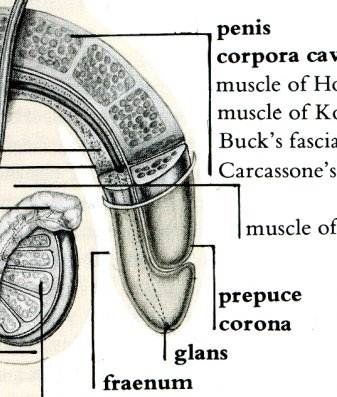
The prepuce is shown almost invisibly pale. The line
from "prepuce" and "corona" ends on the corpora cavernosa, that from
"glans" on the meatus,
and that from the fr[a]en[ul]um on the shaft/foreskin
border. The white ring encircling the penis is
mysterious.
Knight's only illustration of the intact anatomy is
by Vesalius (1543) of which this is an enlarged
detail:

Readers who have never seen an intact penis can be
forgiven for imagining they are looking at a
circumcised one (with a rather small glans). In fact,
Vesalius - who may have never seen a circumcised
penis - was portraying a short penis with a large
glans covered by a foreskin that extends forward in an
acroposthion,
and the folds of the preputial sphincter.
Knight also shows two diagrams of flayed penises -
which of course lack foreskins - calling them
"accurate".
|
"Becoming Satisfied: A Man's Guide to Sexual Fulfilment"
by Joseph Nowinski, Spectrum/Prentice-Hall, New Jersey, 1980.
356pp.
"Touch your penis next, noting the texture
of its skin and the way it feels when it is stroked. Look at the
glans of your penis (pulling back the foreskin if you are not
circumsized [sic] [The only
reference in the entire book to the existence of the
foreskin.]) and the shaft. Stroke the glans
lightly with your fingertips and notice the sensitivity. See if
there are places on your glans that are more sensitive than
others."
"Your body contains many erogenous zones....
The one erogenous zone men tend to focus on is the glans, or
head, of the penis. ... However, it would be a mistake to think
that this is the only erogenous zone on a man's body. He can,
and will, get turned on by having many other parts of his body
caressed, for example, his lips, nipples, ears, and thighs.
"Each of the above sources of erotic
stimulation contributes something to your total sexual arousal.
The more you are able to use each of these channels of
stimulation, the more turned on you will be.... the man who is
able to utilize, say, four separate channels of stimulation is
in a position to get more highly aroused than a man who can use
only one. It also makes it more likely that his arousal will get
high enough for him reach orgasm. How many he uses depends, of
course, on both him and his partner."
"Wisdom of the Body" by Sherwin Nuland (Knopf, New York
1997) describes the glans as "exquisitely
sensitive". It says the value of the foreskin is
controversial, and then proceeds to witter on about the "value"
of the foreskins harvested by David
as a bride-price.
"The Ultimate Guide to Fellatio" by Violet Blue (Cleis
Press 2002) has only circumcised penises in its illustrations,
refers only in passing to the foreskin.
"The Ins and Outs of Gay Sex: a Medical Handbook for Men"
by Stephen E Goldstone (Dell, New York, 1999) has four pages
headed "Circumcision". He claims medical benefits for infant
circumcision, but counsels adults against it. He refers to the
foreskin's rolling action. He warns
that "stretching" the foreskin may
desensitise it - his only reference to it having any sensitivity
to lose. Of docking he
says with no evidence (nor, one may guess, experience), "any
pleasure may be more psychological than physical" (whatever that
may mean - and it would be no less true pleasure for that).
"Tackle Happy: 2 men, 2 dicks, 2 much spare time" a
74-minute documentary about two Australians who tour Australia
with their show, "Puppetry of the Penis" (a sort of adults-only
version of making hand-shadows on the wall). Both men are
circumcised, but a talkback host who rings them while they're
performing at a wildlife reserve comments about "fauna, flora
and foreskins". They do not contradict him.
"Secret Men's Business - Manhood: the Big Gig" by John
Marsden, Pan, 1998
has two pages about the penis, 16 pages about puberty, 16 about
sex and only brief definitions of the foreskin and circumcision
in the glossary.
Oral Sex He'll Never Forget by Sonia Borg, Quiver 2009
This has one short paragraph about the foreskin. "...[the
foreskin is skin that covers the glans ... and is removed by
circumcision]". Earlier it says the glans is the most sensitive
part of the penis. There is of course nothing about how to use
the tongue, teeth and lips on the foreskin.
"Manhood: The Rise and Fall of the Penis" by Mels Van
Driel, Reaktion, 2010

(short-changes the man-hood)
Mentions the foreskin only as it pertains to possible illness and
its treatment - the accumulation of smegma, the development of phimosis. Does discuss the history of the
medicalization of circumcision from the Victorian Era to today,
but does not challenge medical claims for it. All pictures and
diagrams portray the penis without the foreskin (Van Driel claims
that Michelangelo's David on the front cover is also
circumcised). [From a review by Joe Cortez]
"The Human Body: a Visual Guide to Human Anatomy" by Dr
Sarah Brewer, Quercus (London) 2010
Male Reproductive System
...
Penis ...
It is covered in a loose sleeve of thick hairless skin
containing muscle fibres that folds over itself to form
the prepuce (foreskin). The prepuce is tethered to the
glans penis on the underside to form a bridge of skin,
the frenulum, which contains a small artery. The
foreskin helps to keep the glans penis moist and
sensitive. In circumcised males, the forekin is
surgically removed (usually soon after birth for
religious reasons. After circumcision the skin of the
glans penis loses its soft moist texture, more fibrous
protein (keratin) is laid down and the glans become more
like normal skin. Some sexual sensitivity may be lost.
|
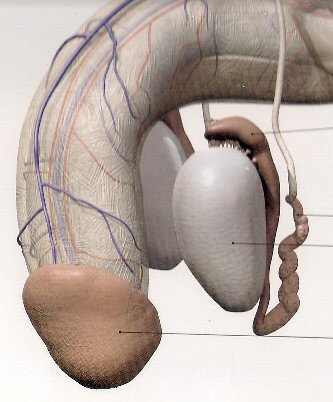 |
- Penis
forms a shaft topped by the glans penis - the most
sensitive part.
|
Atlas of Human Anatomy
Jorde Vigué
MedPluS, Waltham Abbey, UK, 2018
The word "foreskin" is absent from the index but "prepuce" has
eight entries. Several illustrations show apparently cut
penises. The prepuces shown are poorly drawn, as if
single-layered and adhering to the glans, similar to that in the
Getty image above. None has an
acroposthion. The editor of the whole genital anatomy section is
an ob/gyn.
|
|
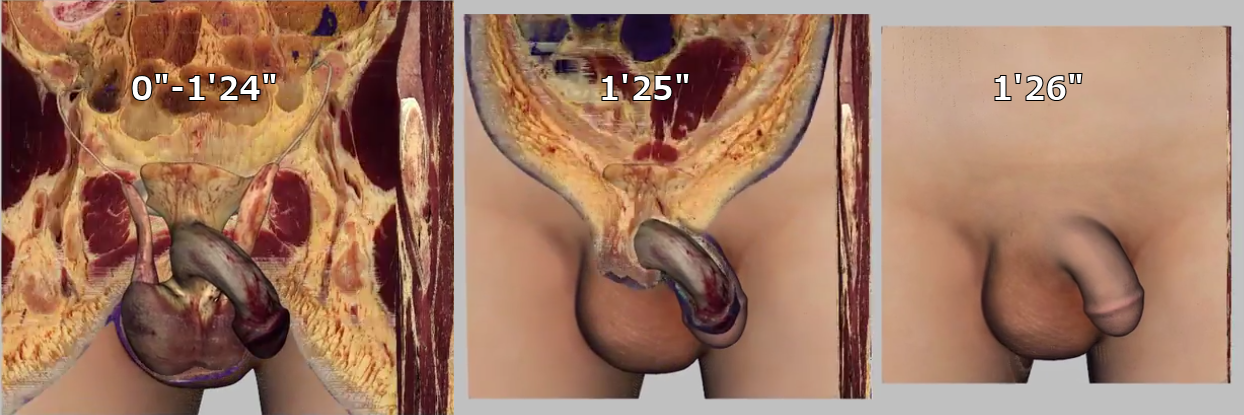


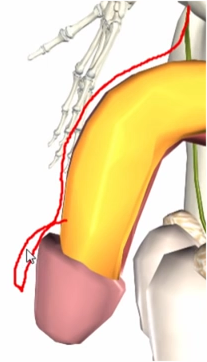




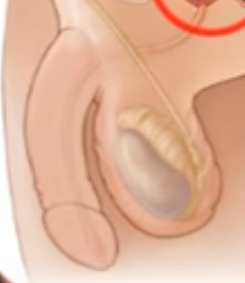
![Anatomical diagram from ''The [Inc]omplete Guide to the Penis''](Images/%27%27complete%27%27.gif)










